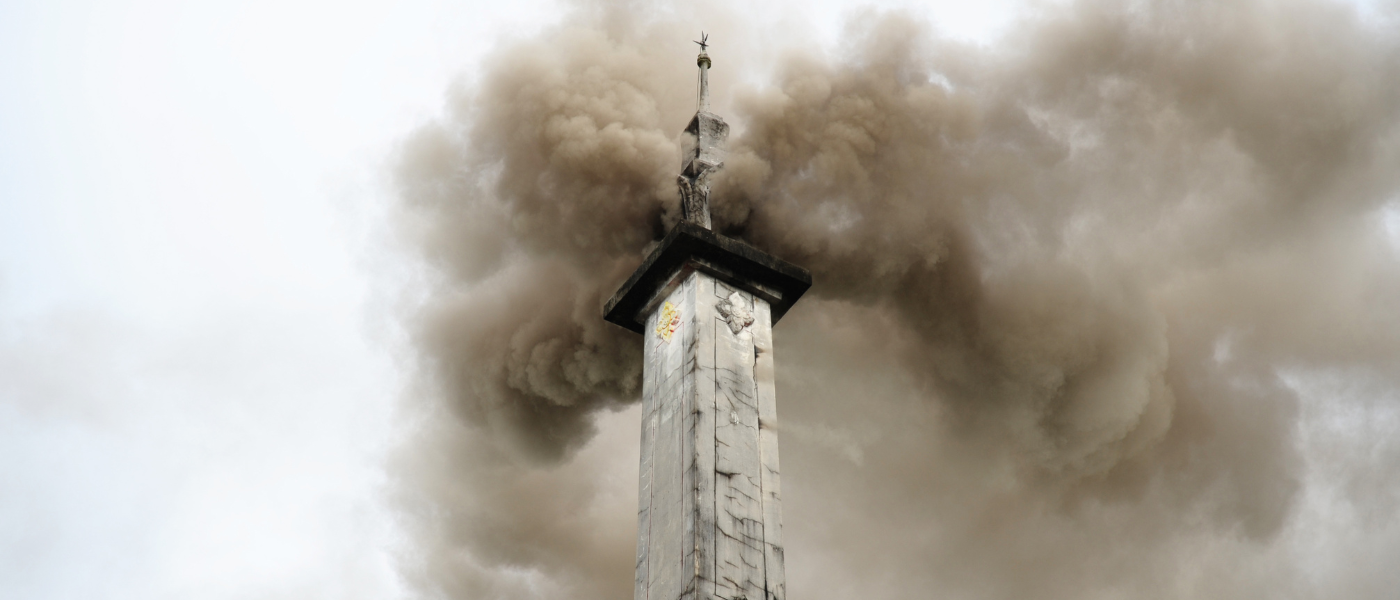The Real Impact of Flame Cremation (Disposition Eco-Impact, Part 2 of 5)
When comparing the eco-impact of funeral options, it’s important to know the carbon footprint of the most popular disposition method in the US today: flame cremation. In part 1 of this series, we looked at the actual environmental impact of traditional burial practices. This week, we take a deep dive into flame cremation, which has been the disposition method of choice for more than half of deaths in the US for years now. As you well know, CANA’s 2023 Annual Statistics Report revealed that 2022’s cremation rate grew to a whopping 59%, continuing the upward trajectory deathcare has experienced over the last few decades.
In our service-driven profession especially, it’s important to offer what today’s families value. More and more research shows that what consumers across generations want are eco-conscious options, and over 65% of consumers are willing to change their purchasing habits to be more “green.” A 2020 study on consumer purchasing habits by IBM Business Institute states that, “nearly six in 10 consumers surveyed are willing to change their shopping habits to reduce environmental impact. Nearly eight in 10 respondents indicate sustainability is important for them. And for those who say it is very/extremely important, over 70 percent would pay a premium of 35 percent, on average, for brands that are sustainable and environmentally responsible.” Death planning purchases are no exception to this rule, and understanding the total environment of flame cremation can help your business make better choices and attract more eco-conscious cremation families.
Flame Cremation
Though once an outlier in deathcare practices, cremation is now the disposition method of choice for at least 59% of all deaths in the US according to CANA’s 2023 Annual Report. Many institutions in the profession predict that cremation will only continue to grow in popularity at steady and predictable rates.
Well known factors like convenience, affordability, lifestyle philosophies, and shifts in religious preferences have led to the increased popularity of cremation over the past few decades, but environmental awareness is also a contributing factor. We now know that more funeral consumers are making death planning choices based on personal beliefs and family traditions, not financial factors. According to research by USA today, “[A] survey found 47% of Americans opt for burial plans based on personal beliefs, while 24% say family traditions influence their decision. Only 14% of Americans ascribe financial reasons as the determining factor for their choice.”
These statistics are especially useful when looking at the consistently rising cremation rates of the past ten years, and can help us recognize that the personal beliefs of death planners, including eco-consciousness, have been a huge factor in cremation’s growing popularity. The research showing that 65% of consumers are willing to change purchasing habits for greener options, makes sense when considering that these purchasing shifts are based on personal belief systems and a desire to leave a legacy of environmental sustainability. While cremation is by no means a perfect eco-friendly disposition method, it is a huge improvement over traditional burial with embalming.
To learn more about how cremation stacks up to other disposition methods when it comes to eco-impact, and discover ways to make flame cremation even more environmentally friendly, download the free ebook, The Real Eco-Impact of Disposition Methods by clicking below:
Materials Usage
Most traditional burials require the use of huge amounts of materials including wood, metal, cotton fabric, concrete, stone, and chemicals. Cremation in its most basic form requires only the materials needed for the container that will hold the deceased person in the retort during the cremation. In theory, these containers could be simpler in construction and use far fewer materials than traditional burial caskets. However, funeral professionals often balk at the idea of a cardboard or simple wooden container, even though many families would be perfectly fine with these options. As a middle ground option, there are products available that provide a well designed, dignified send-off without wasting tons of valuable resources. These options are currently only available in Europe and the UK, so the US market is wide open for better eco-friendly cremation caskets.
Emissions and Greenhouse Gasses
According to research from CANA, the emissions from each cremation are equivalent to one tank of gas in a sedan or powering a 3 bedroom home for one week. While on an individual basis this may not seem like a huge carbon footprint, emissions at this level can add up quickly. According to the Natural Death Centre, “One cremation uses as much energy in the form of gas and electricity as a 500 mile car trip, and releases a staggering 400 kilos of carbon dioxide into the atmosphere, not to mention mercury vapor and other pollutants.In the UK in 2013, over three quarters of funerals end in a cremation. With a death rate of around half a million people every year, this means around 375,000 cremations are taking place annually, potentially releasing some 150,000 tons of carbon dioxide into the air above us.”
Considering numbers from the year 2022, it becomes apparent how quickly these emissions can add up. The CDC tells us that in 2022, 3,273,705 people died in the United States. According to CANA and NFDA, 59% of those deaths were flame cremations. 59% of 3,273,705 is 1,931,485 which means that cremation emissions for the year 2022 are the same as the emissions made by powering nearly 2 million 3 bedroom homes for one week, or filling nearly 2 million tanks of gas.
Additionally, if large caskets with high material usage rates are used, fossil fuels used in shipping and transportation of materials should also be factored in. According to the IEA, International shipping accounted for ~2% of global energy-related CO2 emissions in 2020, and while materials shipping for caskets, markers, and death product manufacturing is probably a small fraction of that global total, caskets and funeral supplies are not small or light and the impact from shipping them is still significant. Taking steps to use biodegradable, locally sourced, and eco-conscious cremation containers in our retorts will have a huge impact on how eco-friendly our cremations really are.
Mercury
It is a fact that cremation releases volatilized mercury into the air in small amounts. According to this study from the National Library of Medicine, in BC, it is estimated that approximately 1.20 grams of mercury is emitted to the atmosphere per body cremated. Those levels could be slightly higher or slightly lower in individual cases depending mostly on how many mercury dental fillings the deceased person had. Again using the numbers from the year 2022, on average, 2,317,782 grams of mercury are released into the atmosphere from cremation in the US each year.
However, an extensive study by the University of Minnesota revealed that, after thorough research was conducted, mercurial environmental outputs from cremation in the state of Minnesota were in actuality one third lower than previous estimates and projections. On the Deathcare Decoded podcast, Larry Stuart Jr. founder of Cremation Strategies and Consulting and former President of Crematory Manufacturing & Service, references that study when discussing mercury emissions and cremation, “They found that if everyone who died in Minnesota for one year was cremated (which, obviously, that’s not the case), and each of those people had the average amount of amalgam filling in their mouth at the time of cremation… then cremation would contribute only 5% of the total amount of mercury [put into the Minnesota environment for that year.]” When factoring in the shrinking number of mercury fillings, as well as the actual cremation rate which is closer to 50% than 100% in the state in which the study happened, crematory mercury emissions actually account for closer to 2.5% of all mercury emissions in the state. While 2.5% isn’t a huge number percentage-wise, mercury emissions are still an environmental threat, and any work to reduce the amount of volatile mercury put into the atmosphere should be pursued.
Metals Recycling Offsets
While cremation is not one of the most energy efficient disposition methods inherently, metals recycling does mean that a big portion of emissions and energy usage required with cremation can also be offset, lowering the method’s overall environmental impact significantly.
Even though cremation technically uses resources like electricity and fossil fuels, we must take into account the amount of heavy and precious metals that are able to be recycled from these processes, and the energy consumption offset that recycling provides. Information gathered from Aquamation’s environmental impact research states that, “The ability to recycle metals provides an enormous environmental benefit. In fact, a 2011 study on the impact of funeral practices (Keijzer 1, 2) found that alkaline hydrolysis is more environmentally friendly than even natural burial. Even though green burial directly uses the least amount of energy, the reclamation of metals from bodies that undergo alkaline hydrolysis more than offsets this energy gap.”
Fortunately, the same metals recycling practices are used with flame cremation, and offset a large portion of the fossil fuels and carbon output that flame cremation requires. Metals recycling is actually good for both the environment, as well as funeral businesses and their communities. According to this article about dental metals recycling,
“If we have a crematory that does 2000 cremations annually, they are generating an average of $50 per cremation from metal recycling. It all depends on the demographics of the families that they serve, but on average, at 2000 cremations a year, that’s about $100,000 per year from recycling metals alone […] No funeral home wants to come across as greedy or appear to be profiting from a family’s deceased loved one, so most businesses agree that dental recycling is an excellent opportunity to give back to their local community, or a greater cause. And, even though the value of these metals seems huge at first, most of the income, if not given away, is put towards equipment repair and upkeep, and doesn’t make up a huge portion of a funeral business’ income.”
When it comes to the other heavy metals that need to be recycled from human remains, research from Aquamation elaborates, “We can look to the types of metals used for implants and how they are made to understand the environmental credit of the recycling. Most medical implants are made of titanium. While titanium is the ninth most abundant element on Earth, its acquisition comes with a steep environmental cost. The cost to obtain and transport the materials used to make titanium – often from other countries – is one aspect, while the actual process to turn it into usable products is another (extraction, purification, reactor, alloy creation, and byproduct management). According to the United States Geological Survey, the US has become highly dependent on the import of materials used to make titanium. A 2017 Italian study (De Angelis, et al.) found that the average person contains one half pound of metal from implants. Metal implants are even more common in the United States and Canada”
The metals recycling that flame cremation makes possible offers a huge benefit to the environment by making mining and new metals acquisition less necessary and recirculating metals that we already have access to back into the market. Data shows that metals recycling can be calculated into directly offsetting the fossil fuels and emissions that cremation requires.
The Hidden Impact of Scattering
While there are many different ways to lay cremains to rest, scattering has consistently been increasing in popularity along with cremation itself. According to the Wall Street Journal, “Choosing to scatter the ashes, rather than preserve them in an urn or bury them in a cemetery, is also becoming more popular. The Cremation Association’s surveys indicate that about 135,000 families are now choosing to scatter ashes each year. Since the average body yields five pounds in cremated remains, that means some 338 tons of human ashes are spread around annually.” However, many people aren’t aware of the harmful eco-impact that cremains can have on the environment.
Recent studies from Los Alamos National Labs have shown that traditional cremains have a high alkalinity, and thus can affect the PH and salt content of soil and water, which thus impacts plant and animal life in that area. However, there is now an alternative form of remains to “ashes” after cremation called solidified remains which minimize the impact of cremains on the environment when left outside or scattered.
To learn more about more about solidified remains and eco-conscious scattering rituals for your families, download the free ebook, The Real Eco-Impact of Disposition Methods by clicking below:
The Importance of Greener Flame Cremation
Cremation rates have been steadily rising and reflect shifts in funeral consumer purchasing based on lifestyle philosophy and personal values, including eco-consciousness. Equipped with the knowledge that growing numbers of consumers are looking for greener options, and that the environmental impact of funeral options could be playing a role in cremation’s rise in popularity, it will only help funeral businesses to find ways to make flame cremation even better for the environment.
Investing in top-notch filtration systems for our crematories, offering options for greener cremation products, and building online arrangements and shopping into our business models (which reduces paper, energy, and fossil fuel usage day-to-day) and letting families know that these efforts are being made, will go a long way to helping your green-seeking clients feel seen, heard, and served.
To learn more about how to make flame cremation a more eco-conscious choice for your families, download the free ebook, The Real Eco-Impact of Disposition Methods by clicking below:




